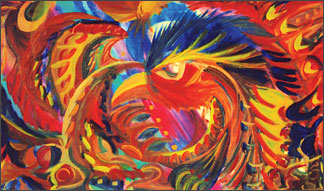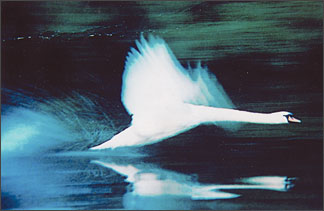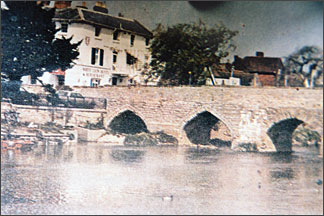The quaint beauty of stratford during Shakespeare’s time
Gwen Herat

The Globe Theatre, Southwark where many of Shakespeare’s plays
were first performed during his time. The Globe was opened in
Bankside in 1599. It was destroyed in 1613. |

The symbolic swan of Shakespeare still glides over the waters of
River Avon. |

The old Clopton Bridge with River Avon flowing ‘neath it. The
bridge has been replaced since but most of the buildings have
been restored and retained like the one seen in the picture. |
The wild flowers of the countryside radiating in the warm sun beneath
the open skies; Bees swarming around the blooms and birds chirping
beneath the bough: The fresh water of river Avon, swirling downstream;
These and many others may have fired the imagination of young
Shakespeare as he played in the nearby woods.
The mysterious Birnam Wood that was to feature in one of his great
tragedies, the crisp wind in the air and the smell of nectar, certainly
motivated the Bard even before he could walk or for that matter, run
across the field.
This was the Stratford he was born in to, unspoilt unpolluted and the
city that was destined to go down into history as the most sought-after
city in the world where thousands, daily, travel from around the world
to pay their respects to the world’s most celebrated icon of English
literature. They would pass the very forest of Arden where Shakespeare
dreamed on and later used it as the setting for As You Like It.
After I played Ophelia in Hamlet as a fifteen-year-old in an
inter-school drama, I little imagined that one day I would pick up my
pen and praise the Bard for the world to read. That I would visit his
Birthplace over and over and over again and still feel very passionate
about it.
That I would write a classic (The Spirits of Romeo and Juliet)
involving him and the press and critic to rave about it. That this
classic would be displayed at the Library in Stratford. So, Shakespeare
invited me into his life.
Ever since I was introduced to Shakespeare by my English teacher, he
remains my favourite author and to be a subject on which I wouldbe
writing unceasingly. I still research his work in the hope that I may
come across some little thing I may have missed. My passion and
adoration to the Bard keeps up my literary spirit burning.
When I sit to write, there is a tint of excitement and now this
spirit takes me back to the old aura of Stratford when Shakespeare was
born. By that time Stratford-upon-Avon had established itself as one of
Wawickshire’s most important market towns and already in touch with the
outside world.
It originated as a river-crossing settlement and was the site of
Roman and Saxon occupation. Under the influence of the Guild of the Holy
Cross, from early time Stratford was a meeting place of roads.
It progressed as a small agricultural community to what Canden
described in 1586 as a proper market place. The young King Edward the VI
granted it as a self-governing borough status in 1553.
But, if one were to judge it by modern standards of today, Stratford
which Shakespeare knew was, both small in size and population.
The inhabitants were about two thousand and to walk around the
boundaries needed hardly twenty minutes. The town contained a compact
plan with houses built in timber. This was possible with the abundant of
trees and orchards. Since all houses were half-timbered, the Forest of
Arden supplied the necessary timber.
However, the town was buzzing with schooling, and business
activities. The markets were laden with corn and malt together with
cattle, horses and sheep - Flourishing side by side was country crafts
and various forms of trades.
The glovers in particular, made their industry very profitable and
Shakespeare’s father belonged to this trade. John Shakespeare was
closely linked with Warwickshire countryside that stretched to Stratford
and was a lively fascinating whose community life typified the common
Elizabethan England.
From two thousand during his time, the basic population has grown to
over twenty thousand. Stratford’s essential role presently is to provide
facilities to the market town for the sale of produce and cattle from
surrounding countryside. Since lately, small-time industries have sprung
up such as printing, canning of fruits, preservation of dairy goods and
development of aluminium goods.
Yet, Stratford retains its old world charm, the character with which
it was associated centuries ago and before the Bard was born. Apart from
the beauty of its river, most of the streets and buildings preserve many
links with the past.
The layout and the names of its central streets have not changed
since medieval time. For instance, the Clopton Bridge was built over
five centuries ago and the fifteenth century range of guild buildings
sustain their origan structures. Even the timber-framed houses of
Elizabethan and Jacobean date, survive side by side with brick and
semi-modern buildings.
The Shakespeare Property Trust maintain the buildings in their
original form to the best of their ability. If William Shakespeare was
to take a walk through these properties, it will be the same as he did
centuries ago. The same flowers in their beds. The same trees replaced.
The quaint beauty of the atmosphere, the same birds chirping during the
day and the eery cricket by night.
However, it is the fame and mystique associated with the properties
of William Shakespeare and his family along with the Shakespeare
Festival centred on the Royal Shakespeare Theatre that make
Stratford-upon-Avon a Mecca for visitors from all over the world and a
centre for academic study.
The Shakespeare Centre built to commemorate the 400th anniversary of
the Bard’s birth, occupies a site overlooking the garden. It serves both
as the Headquarters of the Birthplace and as a study centre. The centre
extension opened in 1981, provides reception facilities for the
visitors. |

